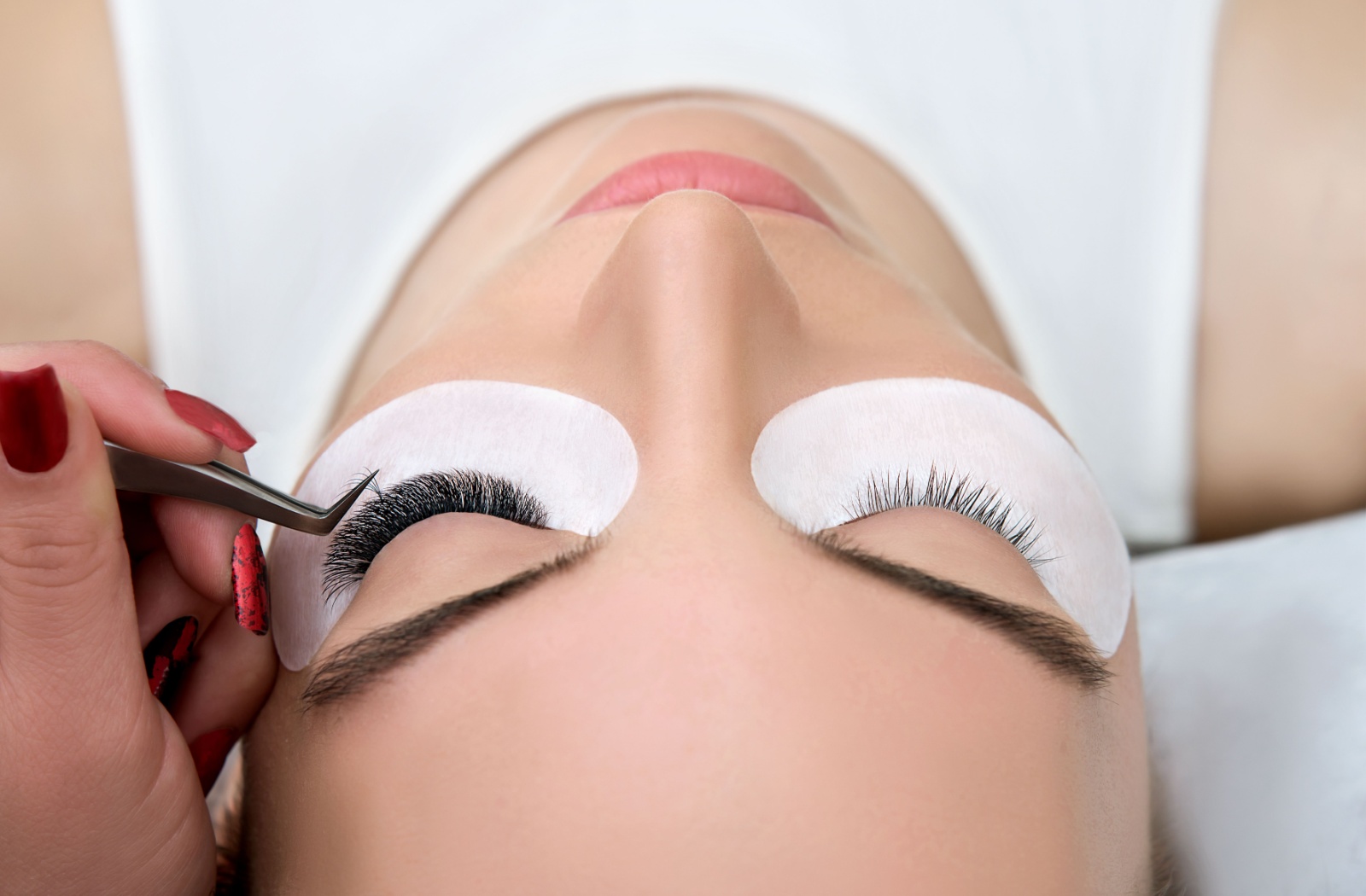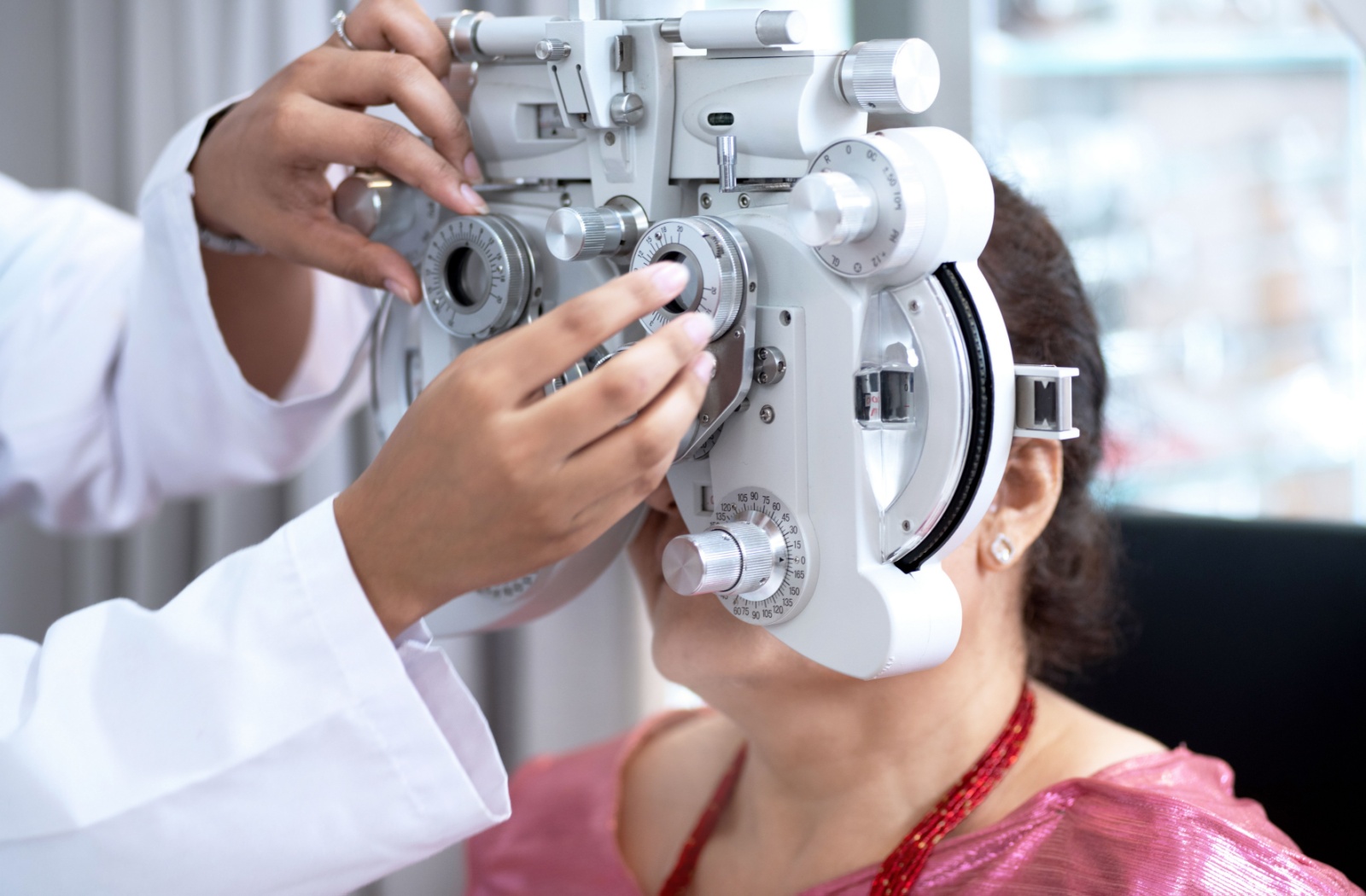Detecting & Diagnosing Eye Disease
Eye exams are an important tool for the early diagnosis of eye disease. Many eye diseases progress slowly, with no pain or symptoms, and by the time you notice any vision changes, it can be too late.
Early identification is crucial for treating and managing eye diseases. If your optometrist is able to make a diagnosis in the beginning stages, there is a higher chance of slowing the progression of a disease and preventing vision loss.
Regular, comprehensive eye exams help your optometrist monitor changes to your vision over time. Year-over-year imaging and assessment can highlight the small changes that may indicate the development of an eye disease.
To learn more about the equipment we use to assess your eyes, visit the Our Technology page.

Advancements in Eye Care Come Standard Here
We offer the AdaptDx diagnostic tool to test for age-related macular degeneration (AMD).
At Advance Eye Care Center, we’re now including AMD testing with AdaptDx as a standard in all our eye exams for:
- Those between the ages of 50 and 80
- Patients outside this age range with:
- Poor night vision
- Personal risk of AMD
- Clinical signs of AMD
AdaptDx accurately and comfortably measures dark adaptation of the eye—how quickly the eye regains its sensitivity to the dark after exposure to bright lights.
Since poor night vision is one of the earliest signs of AMD, the AdaptDx can uncover the possibility of AMD before it can cause irreversible damage, significantly improving patient outcomes.
Glaucoma
Glaucoma is a group of eye diseases generally characterized by damage to the optic nerve, usually due to high intraocular pressure.
Pressure builds up inside the eye, damaging the optic nerve and causing irreversible vision loss. Often, the progression of glaucoma is slow and symptom-free, so regular, comprehensive eye exams are key to detecting this disease.
Types of Glaucoma
Open-Angle: Fluid buildup caused by blockage of the eye’s drainage channels can increase intraocular pressure (IOP) and cause open-angle glaucoma. Generally, peripheral vision is the first thing impacted, followed by central vision.
Angle-Closure: Angle-closure glaucoma occurs when the space between the iris and cornea narrows, trapping fluid in the eye. When the pressure rises as a result of this fluid, angle-closure glaucoma occurs. There are two subgroups of angle-closure glaucoma—acute (sudden onset) and chronic (gradual progression). Acute angle-closure glaucoma is a medical emergency.
Secondary: Secondary glaucoma occurs when rising intraocular pressure is caused by eye trauma, injury, or infection.
Normal-Tension: When the optic nerve is damaged, but intraocular pressure remains within normal range, normal-tension glaucoma may be the cause.
Symptoms
Generally, glaucoma impacts your peripheral vision first. Patchy or blind spots in your field of vision may appear in the early stages, followed by tunnel vision in the more advanced stages.
Symptoms of acute angle-closure glaucoma include sudden onset headaches, blurry vision, eye redness, or halos appearing around lights. If you experience any of these symptoms, you should call your optometrist immediately.
Risk Factors & Prevention
Glaucoma risk factors may include:
- Being over the age of 60
- Having a family history of glaucoma
- Diabetes or heart disease
- High blood pressure
- Corticosteroid use
- Previous trauma to the eyes
Using eye protection to prevent trauma and keeping up healthy lifestyle habits are important tools for preventing glaucoma.
Treatment
There are several treatments for glaucoma, gradually increasing in their level of invasiveness. Most treatment methods are aimed at bringing down the intraocular pressure. Prescription eye drops, drainage implants, and several types of surgery are all available, depending on your particular situation.
It is important to note that there is no cure for glaucoma. Prevention and early diagnosis through regular eye exams are critical.
Cataracts
When the clear lens of your eye hardens, forms a cloudy buildup, and becomes opaque, this is called a cataract. Many people live with cataracts, but in their advanced stages, they may obscure vision and make performing daily tasks very difficult.
Symptoms
Cataracts often develop without pain, but the following symptoms may indicate their formation:
- Halos around lights
- Foggy or blurry vision
- Light sensitivity
- Dull, muted colours
Risk Factors & Prevention
The following factors may increase your risk of developing cataracts:
- Aging
- Sun exposure
- High blood pressure
- Previous eye injury
- Smoking
- Previous eye surgery
Eating a diet high in vitamins C and E, smoking cessation, and protecting your eyes from UV rays may help prevent the development of cataracts.
Treatment
Glasses and contact lenses can clear up mild vision loss due to cataracts. But, if the condition is in an advanced stage, cataract surgery may be the only option to restore your sight.
Age-Related Macular Degeneration
Age-related macular degeneration (AMD) occurs when the macula deteriorates. This condition damages your central vision, the part of your vision that enables you to drive, read, and recognize faces. Loss of vision in this area can create a serious impediment to your day-to-day tasks.
Types of AMD
Dry
Dry AMD is the most common type of AMD, accounting for the majority of cases. It occurs when parts of the macula become thinner due to aging and accumulate tiny clumps of protein.
Wet
There are fewer overall cases of wet AMD, yet this type is responsible for the majority of cases of blindness as a result of AMD. Wet AMD occurs when blood vessels grow under the retina, burst, and leak fluid into the macula.
Symptoms
The telltale signs of age-related macular degeneration are blurry spots in the central vision as well as straight lines that appear wavy or curved.
Risk Factors & Prevention
Factors that may increase your risk of developing age-related macular degeneration include:
- UV exposure
- Aging
- High blood pressure
- Family history of AMD
- Smoking
Cessation of smoking and using sun protection can help prevent the development of AMD.
Treatment
Laser therapy and injectable medications may be able to treat wet AMD. Your optometrist can evaluate your eyes and provide a recommendation.
Diabetic Eye Diseases
People with diabetes are at an increased risk of developing eye diseases. Serious complications like diabetic retinopathy and diabetic macular edema can develop, permanently damaging your vision.
To learn more about these and how we can assist, please visit our diabetic eye exams page.
Keep Your Eyes Healthy
Comprehensive eye exams are crucial for your vision health. Book an appointment at Advance Eye Care Center today!
OUR LOCATION
Visit Advance Eye Care Center in Regina, for all your eye care needs. We offer a number of services, including:
- Adult & Senior Eye Exams
- Children’s Eye Exams
- Diabetic Eye Exams
- Dry Eye Therapy
- Eye Disease Diagnosis & Management
- Trigeminal Dysphoria Treatment
- And more!
Interested in our services? Book an appointment below.
AECC Regina
- 3617B Pasqua Street
- Regina, SK S4S 6W8
Hours of Operation
- Monday: 8:00 AM – 5:00 PM
- Tuesday: 8:00 AM – 5:00 PM
- Wednesday: 8:00 AM – 5:00 PM
- Thursday: 8:00 AM – 8:00 PM
- Friday: 8:00 AM – 5:00 PM
- Saturday: 8:00 AM – 1:00 PM
- Sunday: Closed
*in July and August we are closed on Saturdays and open 8:00 AM – 5:00 PM on Thursdays
Our Brands



See Our Google Reviews
Our Blog
Blepharitis from Eyelash Extensions: Signs It’s Time to See Your Eye Doctor
Eye Care, Eye Conditions & TreatmentsEyelash extensions are a popular beauty trend, offering fuller, longer lashes without daily mascara application. But as stunning as they look, they can sometimes lead to an uncomfortable condition known as blepharitis. If you’ve noticed redness, irritation, or crusting around your eyelash line after getting extensions, despite proper care, it’s time to see your eye […]
Eye Exam Regina: What to Expect
Eye Exams, Eye HealthMaintaining healthy vision is a crucial part of overall well-being. Yet, eye exams are often overlooked until something feels wrong. Regular eye exams help detect early signs of vision issues and identify health conditions such as diabetes, glaucoma, and even hypertension. Some common tests you can expect during an eye exam in Regina include: There […]
Myopia Control Lenses: How They Work & Why They’re Effective for Slowing Nearsightedness
Children’s Eye Care, Contact Lenses, MyopiaMyopia, commonly known as nearsightedness, is one of the most widespread vision concerns among school-aged children. While glasses or contact lenses can provide clear vision, they don’t prevent the condition from worsening over time. That’s where myopia control lenses come in. Myopia control lenses work by correcting blurred vision while gently defocusing peripheral vision, which […]
Blepharitis from Eyelash Extensions: Signs It’s Time to See Your Eye Doctor

Eyelash extensions are a popular beauty trend, offering fuller, longer lashes without daily mascara application. But as stunning as they look, they can sometimes lead to an uncomfortable condition known as blepharitis. If you’ve noticed redness, irritation, or crusting around your eyelash line after getting extensions, despite proper care, it’s time to see your eye […]
Eye Exam Regina: What to Expect

Maintaining healthy vision is a crucial part of overall well-being. Yet, eye exams are often overlooked until something feels wrong. Regular eye exams help detect early signs of vision issues and identify health conditions such as diabetes, glaucoma, and even hypertension. Some common tests you can expect during an eye exam in Regina include: There […]
Myopia Control Lenses: How They Work & Why They’re Effective for Slowing Nearsightedness

Myopia, commonly known as nearsightedness, is one of the most widespread vision concerns among school-aged children. While glasses or contact lenses can provide clear vision, they don’t prevent the condition from worsening over time. That’s where myopia control lenses come in. Myopia control lenses work by correcting blurred vision while gently defocusing peripheral vision, which […]


